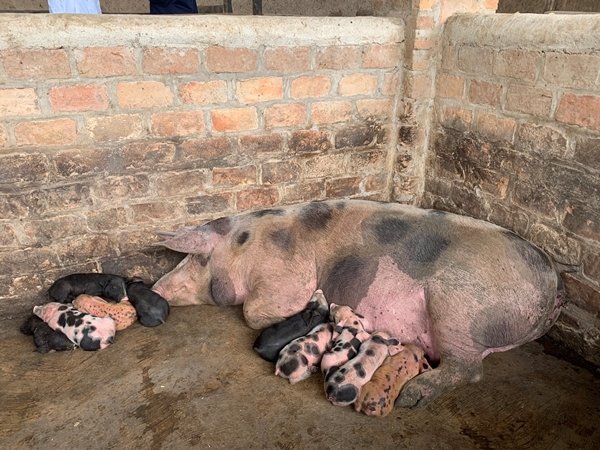
A pig milking her eight piglets
By Teopista Mutesi /FAO
The small livestock sector remains the first avenue for many Rwandans, especially the youth, who want to join farming in different parts of the country. Pig and poultry value chains are preferable partly due to the high rate of return in a relatively short period.
The two value chains also take an important position in Rwanda’s Strategic Plan for Agriculture Transformation (PSTA4) and Livestock Master Plan. However, poultry and piggery farmers say the value chains’ contribution to accelerating agricultural growth continues to be minimal because of several issues, including the need for innovation, capacity development, and better coordination of farmers’ associations.
“We greatly need a new way of doing business in our industry. Many challenges like markets, high-cost animal feeds, and diseases can be easily addressed if all the clusters were better coordinated and capacitated to innovate and practice profitable and solution-based farming,” said Andrew Butare, the Chairperson of Rwanda Poultry Industry Association (RPIA).
Butare spoke during the capacity development planning workshop to set strategic priorities and action plans for piggery and poultry value chains organized by the Food and Agriculture Organization of the United Nations (FAO). The workshop was one of several activities under FAO’s Project: Developing capacities in agricultural innovation systems – scaling up the Tropical Agriculture Platform Framework (TAP-AIS). The European Union funds the Project. Members of the Rwanda Poultry Industry Association and Rwanda Pig Farmers Association were joined by a representative of the Rwanda Agriculture and Animal Resources Development Board (RAB) and Belgium’s Development Agency (ENABEL), among other partners.
Collaboration and coordination
Both poultry and piggery value chains have different clusters that play a pivotal role in promoting the small livestock sector, from farm to table. Strong collaboration and coordination among clusters are critical to making poultry and piggery farming a more profitable and thriving business.
“We want to thank FAO very much for this innovative Project. We have all it takes to develop our sector, but everything is scattered, starting from our name. The name, “Rwanda Pig Farmers Association (RPFA)”, automatically excludes other members from other clusters, like feed processors, meat processors, veterinarians, and other important actors.” said Jean Claude Shirimpumu, Chairman of RPFA. In a bid to develop the capacities of the association to organize, deliver, and network, FAO helped Shirimpumu and his fellow farmers develop an action plan and its implementation mechanisms. They also have agreed to change their name to reflect the inclusivity of members from other clusters in the value chain.
Demand for livestock products
Globally the demand for livestock is expected to grow by 50 per cent by 2050. Africa and southern Asia will drive this growth. According to the Rwanda Environment Management Authority (REMA), Rwanda’s population has grown more than five times in the past 60 years. In July 2021, the population was 12.9 million, a 2.3 per cent increase from 2020. With this annual growth rate, Rwanda’s population could reach 25.8 million by 2050, with a gross density of around 1,000 p/km², the highest in Africa. To satisfy the demand for food in a rapidly growing population, farmers say a new and innovative way of farming to increase production and preserve biodiversity sustainably is greatly needed.
The role of FAO and its partners
For farmers to respond to the growing demand for pig meat, chicken meat, and eggs, they need continuous learning and improvement of their knowledge in marketing, communications, soft skills, and networking capacities. FAO’s TAP-AIS project, together with the EU as a critical partner, aims to help farmer’s mainstream innovation by providing all the functional skills to develop strategic plans for sustainable innovation in the small livestock sector.
“FAO recognizes that innovation is the backbone of smart, resilient, and shock responsive agriculture and food systems”, said Mr. Orlando Sosa, FAO Agricultural Officer at the Subregional Office for Eastern Africa (SFE). “Poor breeds, rampant disease outbreaks, high mortality rates of our small livestock and other numerous challenges can all be defeated when the skills of farmers are improved,” he added.
At FAO, support to farmers to achieve sustainable small-scale livestock production to enhance the contribution of family farmers to achieving the SDGs and to FAO’s Four Betters strategic framework is a priority. The partnership of the FAO, the EU, and the government of Rwanda on the TAP-AIS project is an excellent example of commitment and functional cooperation for achieving these goals. (End)
